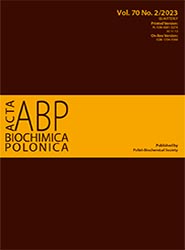Secondary structure in polymorphic forms of alpha-synuclein amyloids
Abstract
Numerous Alpha-synuclein amyloid structures available in PDB enable their comparative analysis. They are all characterized by a flat structure of each individual chain with an extensive network of inter-chain hydrogen bonds. The identification of such amyloid fibril structures requires determining the special conditions imposed on the torsion angles. Such conditions have already been formulated by the Authors resulting in the model of idealised amyloid. Here, we investigate the fit of this model in the group of A-Syn amyloid fibrils. We identify and describe the characteristic supersecondary structures in amyloids. Generally, the amyloid transformation is suggested to be the 3D to 2D transformation engaging mostly the loops linking Beta-structural fragments. The loop structure introducing the 3D organisation of Beta-sheet change to flat form (2D) introduces the mutual reorientation of Beta-strands enabling the large-scale H-bonds generation with the water molecules. Based on the model of idealised amyloid we postulate the hypothesis for amyloid fibril formation based on the shaking, an experimental procedure producing the amyloids.
Acta Biochimica Polonica is an OpenAccess quarterly and publishes four issues a year. All contents are distributed under the Creative Commons Attribution-ShareAlike 4.0 International (CC BY 4.0) license. Everybody may use the content following terms: Attribution — You must give appropriate credit, provide a link to the license, and indicate if changes were made. You may do so in any reasonable manner, but not in any way that suggests the licensor endorses you or your use.
Copyright for all published papers © stays with the authors.
Copyright for the journal: © Polish Biochemical Society.


